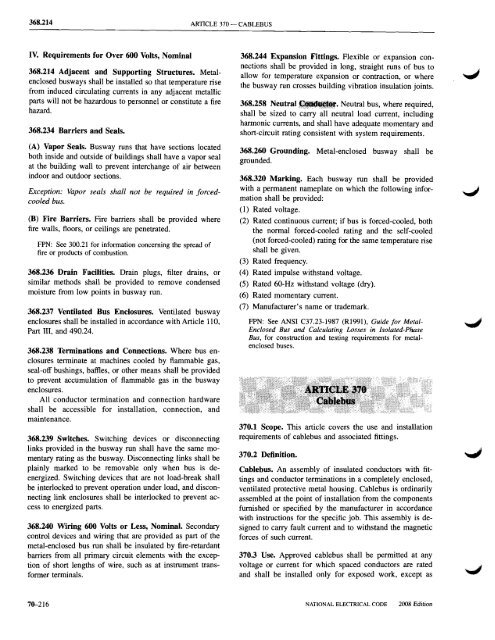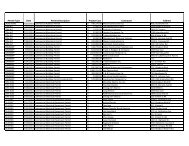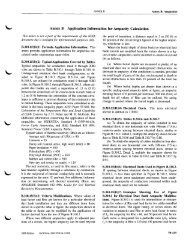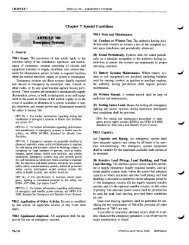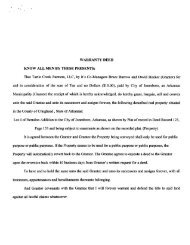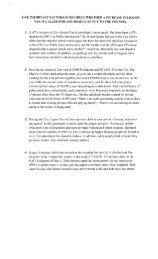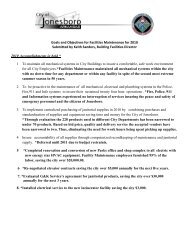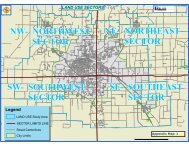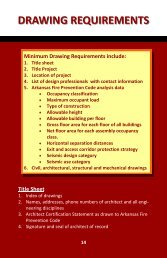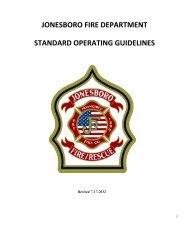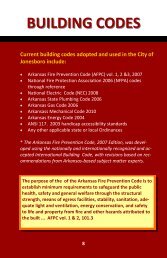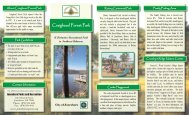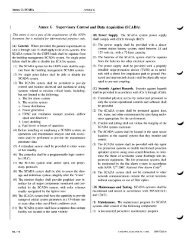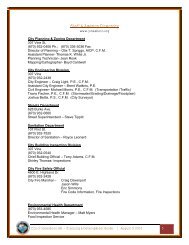Chapter 3 Wiring Methods and Materials
Chapter 3 Wiring Methods and Materials
Chapter 3 Wiring Methods and Materials
You also want an ePaper? Increase the reach of your titles
YUMPU automatically turns print PDFs into web optimized ePapers that Google loves.
368.214 ARTICLE 370 - CABLEBUS<br />
IV. Requirements for Over 600 Volts, Nominal<br />
368.214 Adjacent <strong>and</strong> Supporting Structures. Metalenclosed<br />
busways shall be installed so that temperature rise<br />
from induced circulating currents in any adjacent metallic<br />
parts will not be hazardous to personnel or constitute a fire<br />
hazard.<br />
368.234 Barriers <strong>and</strong> Seals.<br />
(A) Vapor Seals. Busway runs that have sections located<br />
both inside <strong>and</strong> outside of buildings shall have a vapor seal<br />
at the building wall to prevent interchange of air between<br />
indoor <strong>and</strong> outdoor sections.<br />
Exception: Vapor seals shall not be required in forcedcooled<br />
bus.<br />
(B) Fire Barriers. Fire barriers shall be provided where<br />
fire walls, floors, or ceilings are penetrated.<br />
FPN: See 300.21 for infonnation concerning the spread of<br />
fire or products of combustion.<br />
368.236 Drain Facilities. Drain plugs, filter drains, or<br />
similar methods shall be provided to remove condensed<br />
moisture from low points in busway run.<br />
368.237 Ventilated Bus Enclosures. Ventilated busway<br />
enclosures shall be installed in accordance with Article 110,<br />
Part III, <strong>and</strong> 490.24.<br />
368.238 Terminations <strong>and</strong> Connections. Where bus enclosures<br />
terminate at machines cooled by flammable gas,<br />
seal-off bushings, baftles, or other means shall be provided<br />
to prevent accumulation of flammable gas in the busway<br />
enclosures.<br />
All conductor termination <strong>and</strong> connection hardware<br />
shall be accessible for installation, connection, <strong>and</strong><br />
maintenance.<br />
368.239 Switches. Switching devices or disconnecting<br />
links provided in the busway run shall have the same momentary<br />
rating as the busway. Disconnecting links shall be<br />
plainly marked to be removable only when bus is deenergized.<br />
Switching devices that are not load-break shall<br />
be interlocked to prevent operation under load, <strong>and</strong> disconnecting<br />
link enclosures shall be interlocked to prevent access<br />
to energized parts.<br />
368.240 <strong>Wiring</strong> 600 Volts or Less, Nominal. Secondary<br />
control devices <strong>and</strong> wiring that are provided as part of the<br />
metal-enclosed bus run shall be insulated by fire-retardant<br />
barriers from all primary circuit elements with the exception<br />
of short lengths of wire, such as at instrument transformer<br />
terminals.<br />
368.244 Expansion Fittings. Flexible or expansion connections<br />
shall be provided in long, straight runs of bus to<br />
allow for temperature expansion or contraction, or where<br />
the busway run crosses building vibration insulation joints.<br />
368.258 Neutrallil.'I•. Neutral bus, where required,<br />
shall be sized to carry all neutral load current, including<br />
harmonic currents, <strong>and</strong> shall have adequate momentary <strong>and</strong><br />
short-circuit rating consistent with system requirements.<br />
368.260 Grounding. Metal-enclosed busway shall be<br />
grounded.<br />
368.320 Marking. Each busway run shall be provided<br />
with a permanent nameplate on which the following information<br />
shall be provided:<br />
(1) Rated voltage.<br />
(2) Rated continuous current; if bus is forced-cooled, both<br />
the normal forced-cooled rating <strong>and</strong> the self-cooled<br />
(not forced-cooled) rating for the same temperature rise<br />
shall be given.<br />
(3) Rated frequency.<br />
(4) Rated impulse withst<strong>and</strong> voltage.<br />
(5) Rated 60-Hz withst<strong>and</strong> voltage (dry).<br />
(6) Rated momentary current.<br />
(7) Manufacturer's name or trademark.<br />
FPN: See ANSI C37.23-1987 (RI991), Guide for Metal<br />
Enclosed Bus <strong>and</strong> Calculating Losses in Isolated-Phase<br />
Bus, for construction <strong>and</strong> testing requirements for metalenclosed<br />
buses.<br />
370.1 Scope. This article covers the use <strong>and</strong> installation<br />
requirements of cablebus <strong>and</strong> associated fittings.<br />
370.2 Definition.<br />
Cablebus. An assembly of insulated conductors with fittings<br />
<strong>and</strong> conductor terminations in a completely enclosed,<br />
ventilated protective metal housing. Cablebus is ordinarily<br />
assembled at the point of installation from the components<br />
furnished or specified by the manufacturer in accordance<br />
with instructions for the specific job. This assembly is designed<br />
to carry fault current <strong>and</strong> to withst<strong>and</strong> the magnetic<br />
forces of such current.<br />
370.3 Use. Approved cablebus shall be permitted at any<br />
voltage or current for which spaced conductors are rated<br />
<strong>and</strong> shall be installed only for exposed work, except as<br />
70-216<br />
NATIONAL ELECTRICAL CODE<br />
2008 Edition


